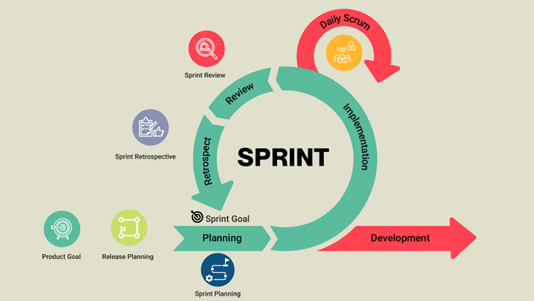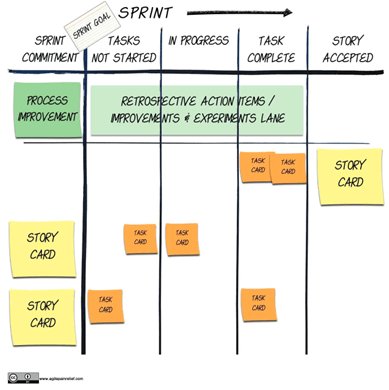Best Agile Practices For Scrum Project Management

Scrum is the most popular agile project management methodology used within software development teams. It focuses on accountability and teamwork, through daily meetings and measurable goals, known as Sprints.
A big advantage of the Scrum method is that teams can complete projects quickly, with minimal setbacks. Daily meetings ensure constant communication, which also improves synergy. Scrum project management is great for large projects that need to be broken into smaller, manageable tasks. Here, project management tools can help with projects from start to finish.
The Agile project management approach is very popular and effective. The Agile meaning we are referring to is an adaptable customer focused approach which encourages communication, detailed feedback, and knowledge sharing.
In this post we’ll take a look at how Scrum project management works and the best Agile practices you can adopt.
#The Scrum framework
#Scrum roles
When following Scrum methodology there are 3 distinct roles which are required for each team to succeed: the Product Owner, Scrum Master, and Development Team. Your team must understand and learn more about the roles and responsibilities within agile DevOps teams before starting the project.
#Product Owner
The Product Owner sets a clear direction for the project. They understand the business requirements, clients’ needs, and user story. From that, they can develop and manage the product. For example, if the client is looking for business VoIP providers in Canada, the Product Owner should understand everything the team requires to deliver a VoIP product.
Key tasks for a Product Owner include:
- Set Sprint goals with the development team;
- Organize the product goals and communicate them to the Scrum Master;
- Manage the product backlog;
- Collect product feedback from stakeholders and users using customer feedback tools or use free QR codes to direct users to feedback forms for quicker and more accessible input.
- Be accessible to the development team to answer questions.
#Scrum Master
The Scrum Master, who usually holds the scrum master certification, is often the glue holding the team together. They assist both the Product Owner and Development Team in delivering value. Being a Scrum Master means supporting the rest of the team in whatever they need, which requires flexibility.
Some of the key responsibilities associated with being a Scrum Master include:
- Facilitate meetings whether they are daily scrum meetings or for lead sprint planning.
- Ensure all members of the team understand the goals and scope of the project.
- Manage all obstacles and keep all stakeholders informed.
- Understand and implement agile practices.
- Conduct reviews retrospectively for future improvement.
#Development Team
The Development Team is everyone else involved in the Scrum. They should have the right skills to deliver an exceptional product or service.
Members of the Development Team are expected to:
- Participate and adapt to daily scrum meetings.
- Contribute to the relevant Sprint goals.
- Deal with the Sprint backlog.
- Development of the project.
- Communication with all stakeholders.
#Scrum events
A Scrum is broken down into events, which drives success and ensures constant communication and collaboration. This cycle is repeated for each Sprint needed to reach the end goal.
Image sourced from tryscrum.com
#Sprint Planning
A Sprint is a term used to describe a development cycle (usually a maximum of one month) which aims towards the end product or service being delivered on time. At the end of each Sprint, the Scrum team should have developed something of value to present to the client. Each Sprint should have a specific target, which is agreed upon by the Scrum team.
For instance, an initial Sprint target could be to research how to build a marketplace and the best method to suit the client’s goals. Or, it may be to write the initial code for a new piece of software.
The team can determine the length of each Sprint based on how long they think they’ll need to complete a task. Using software to improve the speed of your Sprints is a great way to improve client satisfaction. For example, a Development Team can use software like Docker to remove time-consuming and repetitive configuration tasks.
#Daily Scrum
A Daily Scrum is exactly what it sounds like; a daily standup meeting for the Scrum team. For the best practice, try to organize your daily scrums at the same time and same place each day. It should be no longer than 15 minutes.
During a Daily Scrum, each member of the team answers 3 questions. The questions and answers can be effectively recorded and referenced later using an AI meeting note taker.
These questions are usually something like:
- What tasks have I completed since the previous Daily Scrum?
- What am I working on for the next Daily Scrum?
- Is there anything hindering my progress and if so, what could be done to help?
These three questions raise any issues, inform the team, and make sure every team member is on the same page. Any issues should be discussed after the Daily Scrum, with an in-person or virtual brainstorming session.
#Sprint Review
A Sprint Review follows the end of each Sprint. It is a chance to review the software or product and adapt as necessary. This may involve stakeholders, clients, sponsors, and the Scrum team. The focus of the review is to ensure everyone is satisfied with the progress made thus far. It is also an opportunity for feedback. Any ideas can then be put forward when planning the next Sprint.
Free to use image from Unsplash
#Sprint Retrospective
The Sprint Retrospective gives each member of the Scrum team a chance to provide feedback about how the Sprint went. The process can then be reviewed and adapted as needed. This is essential to develop a good Scrum team into an excellent one. It is also a great time to look into how remote developers can be managed effectively and how to boost team productivity. Effective time tracking is also important for optimizing team performance in Scrum. Especially in hybrid or remote environments, using a cloud-based time tracking app for Agile teams helps increase transparency, reduce manual reporting, and provide real-time data. This helps Scrum Masters make informed decisions during retrospectives and Sprint planning.
#Scrum artifacts
Scrum artifacts are an essential part of the Scrum process. They define what tasks must be completed, adding value to every Sprint. Each Scrum artifact provides a structure for the Scrum team and is used as a guideline throughout the project.
While Scrum's structured approach excels in well-defined processes, many teams look for a more adaptable methodology to handle growing project needs. This is where Scrumban comes in—a hybrid framework that combines Scrum’s structure with Kanban’s continuous flow. It offers a balanced approach for teams that value both organization and flexibility, making it a valuable consideration for those refining their agile workflows. Understanding Scrumban can provide deeper insights into optimizing team efficiency and iterative enhancements.
#Product Backlog
The Product Backlog consists of a list of tasks that must be completed to finish a project. These are specific tasks which are broken down into individual components. This will ensure nothing is missed that could be detrimental to the project. After completing the Product Backlog, the Product Owner can prioritize each task for the Scrum team. The Product Backlog may consist of the following items:
- Design issues
- UX changes
- New features
- Feature improvements
- Bug fixes
- Refactoring
- Infrastructure changes
A Product Backlog often changes over time if issues arise, or if the client requests a new feature. Going back to the example earlier, if you are creating Voice over Internet Protocol (VoIP) or call center management software for a client who now wants to add a visual voicemail feature, your Product Backlog should be changed accordingly. Additionally, integrating product operations best practices can further enhance project success and streamline development processes.
#Sprint Backlog
The Sprint Backlog is a feature of the Product Backlog, which the Scrum team should work on during each Sprint. During the Sprint meeting, the Product Owner should assist each team member to create their own Sprint Backlog. This could be tagged as follows:
- Tasks not started
- In progress
- Task complete
Image sourced from agilepainrelief.com
#Increment
An increment is whatever has been produced at the end of the Sprint, through the completion of the Product Backlog tasks. It should include increments from every previous Sprint. The increment should be decided upon during the Scrum Planning session.
#Best agile practices for Scrum project management
Understanding Scrum methodology is only one part of carrying out a successful project. To ensure you see all the benefits of Scrum, you should also follow the best agile practices. Using agile development helps teams adapt quickly, improve as they go, and deliver results faster.
#Emphasizing the importance of clear and measurable goals
For maximum productivity, you should define clear and measurable goals for every team member. You may want to follow the SMART method here, which is a popular agile framework for setting goals. This can be used during Sprint Planning and within the Sprint Backlog. Each team member should re-evaluate their goals when necessary.
#Encouraging frequent and effective communication
To become a project manager or successful business owner, encouraging effective communication is the key to perfect team synergy. This can be done through:
- a clear and set agenda for the Daily Scrum
- weekly calls with each team member
- encouraging the use of in-person meetings or video calls (through software such as Vancouver-based phone systems with Dialpad)
#Regularly reviewing and adjusting the project plan
The project plan could change at any time and thus requires regular reviewing and adjusting, so project deadlines can be met. This involves conversations, and awareness of time efficiency, with the whole team. When reviewing and adjusting the project plan, it provides a clearer view of obstacles or mistakes that can be avoided next time. In Scrum project management, this is usually the task of the Product Owner.
Free to use image from Unsplash
#Prioritizing the most important tasks
Prioritization within Sprint Planning and throughout each Sprint will ensure that the team completes the most important tasks first. The Product Owner can prioritize tasks during the creation of the Product Backlog. Each team member should also be aware of the most important tasks to prioritize. Using agile project management tools is an effective way to streamline this process.
#Implementing continuous integration and testing
Continuous integration is an integral part of project management. The feedback loop within DevOps culture is a perfect example of this. Throughout each Sprint, the software or product should be developed and then tested. This provides an increment at the end of each Sprint. The Product Backlog should be used to define these tasks for each team member.
#Maintaining a flexible and adaptable approach
Being flexible and adaptable in the way that projects are run is an essential component of Scrum project management and agile practices. This is something that can be built within the team over time, especially after completing the Sprint Retrospective. This is a chance to see how to adapt and change to improve communication, efficiency, and productivity. Teams can also explore AI project management tools that provide insights and suggestions to strengthen communication, efficiency, and productivity across sprints.
#Empowering the team to make decisions and solve problems
Although the Scrum Master will be on hand to help, each Scrum team member should be empowered to make their own decisions. These decisions can still be discussed with other team members, but over time, this creates a team that is self-sufficient and self-organized.
Free to use image from Unsplash
#Conclusion
Scrum project management typically involves a small team of four-to-nine people assisted by a Scrum Master and Product Owner. Tasks are completed in short cycles known as Sprints. The team will also have daily meetings known as a daily Scrum. Following agile practices such as empowering the team to make decisions and regularly reviewing the project plan can ensure an effective Scrum.
Starting at just $3.24 / month, get virtual servers with top-tier performance.








